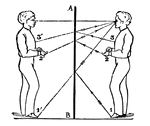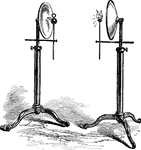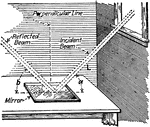Mirrors and Reflections
The Mirrors and Reflections ClipArt gallery offers 57 illustrations related to how light is reflected from flat or curved polished surfaces.
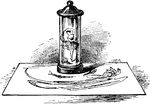
Anamorphoscope
"An optical toy consisting of a vertical cylindrical mirror which gives a correct image of a distorted…

Curved Image
"If the object a be placed obliquely before the convex mirror, then the converging rays from its two…

Inverted Image
"Slit A is a very small opening. The light coming from the soldier on the right shines through the slit…

Isometric Holohedral Mirror
This image represents an isometric holohedral mirror positioned to produce a cube by reflection.
Kaleidoscope
A kaleidoscope is an optical instrument invented by Brewster about 1815. It became very popular as a…
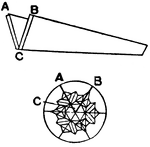
Mirrors in a Kaleidoscope
This illustration shows the arrangement of mirrors in a kaleidoscope (AC and BC), and the patterns formed.

Foci of Concave Mirror
"The foci of concave mirrors may be in front of the mirror, in which case they are real; or they may…
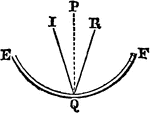
Concave Mirror
"A concave mirror reflects from a curved surface hollowing in like he inside of an orange." —Quackenbos…
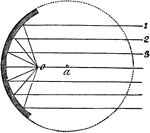
Focus of a Concave Mirror
"The focus of a concave mirror is the point where the rays are brought together by reflection." -Comstock…

Reflection from Concave Mirrors
"Parallel rays of light strike the concave mirror. The rays converge at the focus, F, which is halfway…
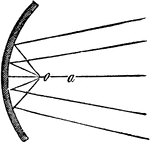
Convergent Rays in a Concave Mirror
"Thus, were the rays falling on the mirror parallel, the focus would be at a' but in consequence of…
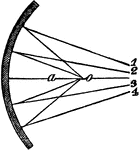
Divergent Rays in a Concave Mirror
"...be made obvious...where the diverging rays 1, 2, 3, 4 form a focus at the point o, whereas, had…

Rays Diverging from Beyond the Center of Curvature on a Concave Mirror
"When the rays diverge from a point beyond the center of curvature, as B, the focus falls on the same…

Rays Diverging from Beyond the Center of Curvature on a Concave Mirror
"When the rays diverge form a point at a distance from the mirror less than that of the principal focus,…

Concave Mirror with Image and Focus
"The focus of each point chose may be determined by tracing two rays from the point, and locating their…
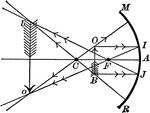
Image Beyond the Curvature of a Concave Mirror
"When the object is at a distance from the mirror somewhat greater than the center of curvature, as…
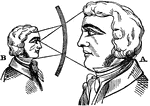
Magnified Face in a Concave Mirror
"When the concave mirror is large, say six inches in diameter, and eight or ten inches focal distance,…

Object Beyond the Focus in a Concave Mirror
"...if the object is placed more remote from the mirror than the principal focus, and between the focus…
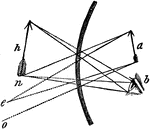
Object Within the Focus in a Concave Mirror
"...let us suppose the object a, to be placed before the mirror, and nearer to it than the principal…

Reflection of Heat Using Concave Mirrors
"Suppose a red hot ball to be placed in the principle focus of the mirror, a, the rays of heat and light…

Spherical Aberration of a Concave Mirror
"The spherical aberration of a concave mirror is the deviation of some of the reflected light from the…

Deception by Mirrors
"Suppose the tumbler, a, to be filled with water, and placed beyond the principal focus of the concave…
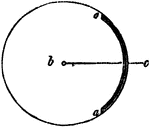
Convex Mirror
"A convex mirror is a part of a sphere, or globe, reflecting from the outside." -Comstock 1850
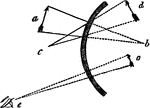
Object Diminished in Convex Mirror
"Hence the image of the object, when reflected from the convex mirror, appears smaller than the object…

Convex Mirror
"To explain this, let us suppose that the arrow a, is diminished by reflection from the convex surface,…
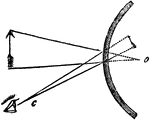
Convex Mirror
"...as the arrow is moved backwards, the angle at c, must be diminished, because the rays flowing from…
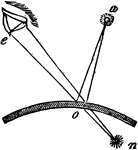
Convex Mirror
"Let us suppose that a, is a luminous point, from which a pencil of diverging rays falls upon a convex…
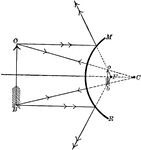
Convex Mirror
"A convex mirror is generally a part of the other surface of a spherical shell. It increases the divergence,…

Convex Mirror Reproducing an Image of an Arrow
"Rays from an object showing the reproduction of an image in a convex mirror." -Avery 1895
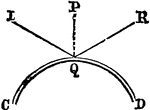
Convex Mirror
"A convex mirror reflects from a curved surface rounding out like the outside of an orange." —Quackenbos…

Reflection by Convex Mirrors
"Parallel rays strike the convex mirror, reflect, and diverge as if they had originated from a virtual…
!["This will be understood [here] where the ray of light A B, proceeding from the eye, falls perpendicularly on the plane mirror B D. will be reflected back in the same line; but the ray C D coming from the feet, which falls obliquely on the mirror, will be reflected back under the same angle in the line D A; and since we see objects in the direction of the reflected rays, and the image appears at the same distance behind the mirror that is object is before it, we must continue the line A D to the feet, E, and for the same reason, the rays A B, from the eye, must be prolonged to F, as far behind the mirror as the line E extends, where the whole image will be represented." -Comstock 1850](https://etc.usf.edu/clipart/35800/35843/mirror3_35843_mth.gif)
Mirror Half the Length of the Object
"This will be understood [here] where the ray of light A B, proceeding from the eye, falls perpendicularly…
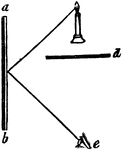
Plane Mirror
"Suppose the mirror, a b, to be placed on the side of a room, and a lamp to be set in antoher room,…
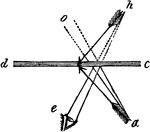
Plane Mirror
"Suppose the arrow a to be the object reflected b the mirror d c; the incident rays a, flowing from…
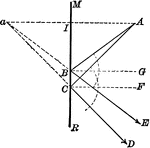
Plane Mirror
"If an object is placed before a plane mirror, a virtual image appears behind the mirror. Each point…

Plane Mirror
"A plane mirror reflects from a flat surface, like a common looking glass." —Quackenbos 1859
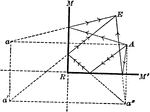
Multiple Images in a Plane Mirror
"By placing two plane mirrors facing each other, we may produce an indefinite series of images of an…
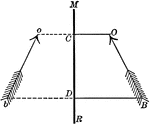
Object in Plane Mirror
"The construction for the image produced by a plane mirror depends upon the fact that the image of the…
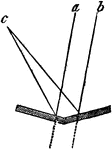
Plane Inclined Mirrors
"The incident rays, a and b, being parallel before they reach the reflectors, are thrown off at unequal…

Reflected Light
"The apparatus shown is used to prove that incident rays and reflected rays are equal." -Avery 1895

Reflection
"Let S be the position of the spectator; O and B the position of distant objects. The rays O R and B…
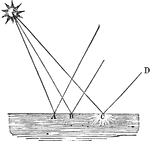
Reflection
"Here, of the rays S A, S B, and S C, only the ray S C meets the eye of the spectator D. The spot C,…

Explanation of Reflection
"Consider a beam of light as made up of a number of ehter waves moving forward in air and side by side,…

Angle of Incidence and Reflection
"Mirror A/B is only half of person C's height. C is able to view his entire body through such a small…

Irregular Reflection or Diffusion
"Irregular reflection or diffusion results from the incidence of radiant energy upon an irregular surface,…
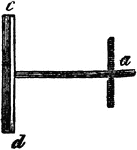
Reflection of Light
"Thus, if a sunbeam, passing through a small aperure in the window shutter a, be permitted to fall upon…
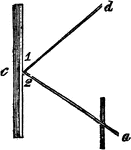
Reflecion of Light
"Let a ray pass towards a mirror in the line a, c, it will be reflected off in the direction of c, d,…

Reflection of Light
"The ray a, c, is the ray of incidence, and that from c, to d, is the ray or reflection. The angles…

Regular Reflection
"Regular reflection results from the incidence of radiant energy upon a polished surface. When a beam…
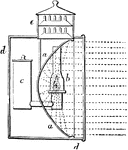
Parabolic, Reflector
A polished surface of metal, or any other suitable material, applied for the purpose of reflecting rays…
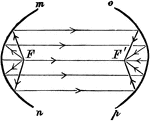
Parabolic Reflectors
"...represents two parabolic reflectors, mn and op. It is a peculiarity of such reflectors that rays…
